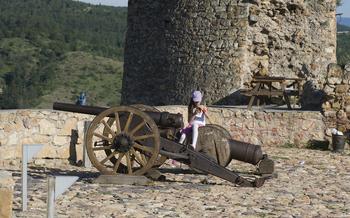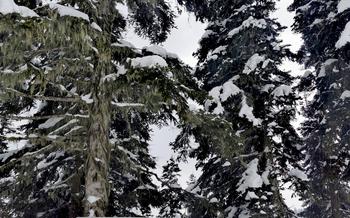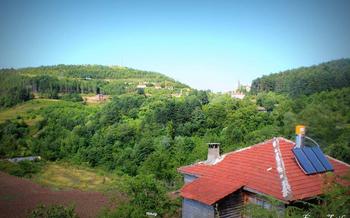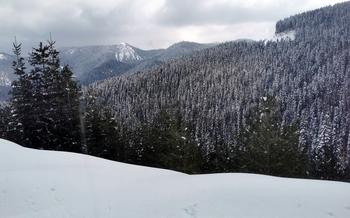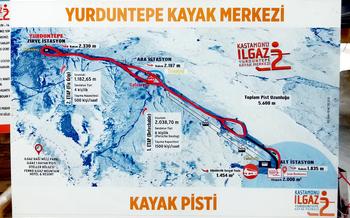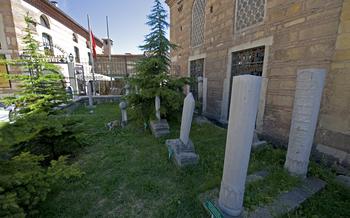
Küre Mountains Hornbeam Forests
- Küre Mountains Hornbeam Forests: A Natural Wonder
- Planning Your Visit to the Forests
- Hiking Trails and Routes
- Camping and Accommodation Options
- Wildlife Watching and Birdwatching
- Cultural Heritage and Local Traditions
- Picnicking and Relaxation Spots
- Photography and Nature Appreciation
- Conservation and Sustainable Tourism
- Guided Tours and Local Guides
- Packing Essentials and Gear
- Safety Precautions and Emergency Preparedness
- Local Cuisine and Gastronomic Delights
- Nearby Attractions and Side Trips
- Insider Tip: Hidden Gems and Secret Spots
Küre Mountains Hornbeam Forests: A Natural Wonder
History and Significance of the Forests
The Küre Mountains Hornbeam Forests, located in the Kastamonu province of Turkey, hold a significant place in the country's natural heritage. These forests, spanning over 126,000 hectares, are renowned for their unique ecosystem and rich biodiversity. They have been recognized as a UNESCO World Heritage Site since 2012 due to their outstanding universal value.
The forests have a long and intricate history, dating back to ancient times. They have been a source of sustenance and livelihood for local communities for centuries, providing timber, fuel, and non-timber forest products. In recent years, the forests have gained increasing recognition for their ecological importance, becoming a popular destination for nature lovers, hikers, and researchers.
Unique Ecosystem and Biodiversity
The Küre Mountains Hornbeam Forests are home to an incredibly diverse range of flora and fauna. The forests are dominated by hornbeam trees, which create a dense canopy that provides a habitat for numerous plant and animal species. The understory is rich in wildflowers, ferns, and mosses, creating a vibrant and colorful tapestry.
The forests are also home to a variety of wildlife, including mammals, birds, reptiles, and amphibians. Notable species include the endangered Eurasian lynx, the brown bear, the red deer, and the eastern imperial eagle. The forests serve as a critical breeding ground and migration route for many bird species, making them a haven for birdwatchers.
Importance of Conservation Efforts
The Küre Mountains Hornbeam Forests face various threats, including climate change, deforestation, and unsustainable tourism practices. Conservation efforts are crucial to protect this unique and valuable ecosystem.
The UNESCO World Heritage designation has provided international recognition and support for the conservation of the forests. Local communities, conservation organizations, and the government are working together to develop sustainable management plans, promote responsible tourism, and raise awareness about the importance of preserving this natural treasure.
Planning Your Visit to the Forests
To make the most of your visit to the Küre Mountains Hornbeam Forests, careful planning is essential. Here are some key considerations:
Best time to visit: The forests are accessible year-round, but the ideal time to visit is during the spring (April-May) or autumn (September-October) when the weather is pleasant, and the forests are adorned with vibrant colors.
Accessibility and transportation options: The forests are located approximately 160 kilometers northeast of Kastamonu city. Public transportation options are limited, so it's recommended to rent a car or arrange for private transportation.
Permits and regulations: To enter the forests, a permit must be obtained from the Kastamonu Directorate of Forestry. Permits can be easily obtained online or in person at the forestry office. Visitors must adhere to park regulations, including staying on designated trails, camping only in designated areas, and respecting wildlife.
Hiking Trails and Routes
The Küre Mountains Hornbeam Forests offer a diverse network of well-maintained hiking trails that cater to hikers of all skill levels, from beginners to experienced trekkers. Whether you prefer leisurely strolls through the forests or challenging ascents to panoramic viewpoints, you'll find a trail that suits your preferences.
-
Beginner Trails: The forests have several easy trails suitable for beginners and families with young children. These trails are mostly flat or have gentle slopes, making them accessible to hikers of all fitness levels. Highlights of these trails include scenic vistas, tranquil forest streams, and abundant birdlife.
-
Intermediate Trails: For those seeking a more challenging experience, there are intermediate trails that lead to higher elevations, offering stunning views of the surrounding mountains and valleys. These trails require a moderate level of fitness and may involve some steep sections and uneven terrain.
-
Advanced Trails: Experienced hikers can embark on advanced trails that venture into the heart of the forests, reaching remote summits and hidden waterfalls. These trails require excellent physical condition, proper gear, and navigation skills. The rewards are breathtaking panoramas, encounters with rare wildlife, and a sense of accomplishment.
-
Trail Maps and Resources: Before embarking on your hike, obtain a detailed trail map from the visitor center or local tourism offices. These maps will help you navigate the trails safely, identify landmarks, and plan your route. Additionally, there are several guidebooks and online resources available that provide detailed information on each trail, including difficulty level, estimated hiking time, and points of interest.
Camping and Accommodation Options
When planning your visit to the Küre Mountains Hornbeam Forests, you'll have several options for camping and accommodation to suit different preferences and budgets.
Designated Campsites:
-
Within the forests, there are designated campsites equipped with basic facilities like picnic tables, fire pits, and restrooms. These campsites offer a rustic and immersive experience, allowing you to camp amidst the tranquil surroundings.
-
Booking in advance is recommended, especially during peak season, to secure your spot. Reservations can be made through the local forestry office or online platforms.
Accommodations Near the Entrance:
-
If you prefer more comfortable accommodation, several hotels, guesthouses, and lodges are located near the entrance of the forests. These options offer a range of amenities, including private rooms, hot showers, and Wi-Fi.
-
Staying near the entrance provides easy access to the forests and allows you to explore the surrounding area, including nearby villages and attractions.
Tips for Camping and Backcountry Etiquette:
-
Respect the natural environment by following proper camping etiquette. Leave no trace of your presence, pack out all trash, and avoid disturbing wildlife.
-
Be mindful of noise levels, especially at night, to ensure a peaceful environment for fellow campers and wildlife.
-
Campfires are permitted in designated areas only. Always build fires responsibly and extinguish them completely before leaving.
Wildlife Watching and Birdwatching
The Küre Mountains Hornbeam Forests are a haven for wildlife enthusiasts, offering a diverse range of animal and bird species. From majestic birds of prey soaring through the skies to elusive mammals roaming the forest floor, there's something to captivate every nature lover.
One of the highlights of wildlife watching in the forests is the opportunity to spot the endangered eastern imperial eagle, a magnificent raptor with a wingspan of up to 5 meters. Other notable bird species include the Egyptian vulture, short-toed snake eagle, and booted eagle.
For those interested in mammals, the forests are home to a variety of species, including wolves, bears, lynx, and wild boar. While sightings of these larger animals can be rare, there are plenty of smaller mammals to observe, such as squirrels, rabbits, and foxes.
To enhance your wildlife watching experience, it's recommended to bring binoculars or a spotting scope. There are several designated wildlife observation spots within the forests, and local guides can provide valuable information on the best places to spot specific species.
Remember to practice responsible wildlife observation by maintaining a respectful distance and avoiding disturbing the animals. Your patience and respect will be rewarded with unforgettable encounters with the incredible wildlife of the Küre Mountains Hornbeam Forests.
Cultural Heritage and Local Traditions
The Küre Mountains Hornbeam Forests are not only a natural paradise but also a region rich in cultural heritage and local traditions. Several villages and communities are nestled within the forests, each with its unique customs and way of life. Visitors to the forests have the opportunity to immerse themselves in the local culture and experience the warm hospitality of the people.
One of the highlights of the cultural experience in the Küre Mountains is the traditional village life. Visitors can witness the daily routines of the locals, such as farming, weaving, and woodworking. They can also learn about the traditional crafts and techniques that have been passed down through generations.
For those interested in history, there are several historical sites within the forests, including ancient ruins, castles, and mosques. These sites offer a glimpse into the region's rich past and provide an opportunity to learn about the different civilizations that have inhabited the area.
Visitors to the Küre Mountains Hornbeam Forests should also take the time to sample the local cuisine, which is known for its delicious dishes and unique flavors. Local specialties include keşkek, a hearty dish made from wheat and meat, and pişmaniye, a sweet pastry made from flour and sugar.
Overall, the Küre Mountains Hornbeam Forests offer a unique blend of natural beauty and cultural heritage. Visitors to the forests can not only enjoy the stunning landscapes and diverse wildlife but also immerse themselves in the local traditions and customs, making their trip a truly memorable and enriching experience.
Picnicking and Relaxation Spots
Amidst the tranquility of the Küre Mountains Hornbeam Forests, numerous scenic spots beckon picnickers and nature enthusiasts seeking relaxation. These designated areas offer a harmonious blend of natural beauty and amenities, ensuring a comfortable and enjoyable experience.
Designated picnic areas, equipped with sturdy tables and seating, are strategically positioned throughout the forests. These spots are carefully chosen to maximize the breathtaking views and provide a serene ambiance. Embrace the tranquility as you spread out your blanket, unpack your picnic basket filled with local delicacies, and savor the fresh mountain air.
For those who prefer a more secluded experience, venturing off the beaten path to discover hidden clearings or serene riverbanks is highly rewarding. Find a spot beneath the shade of ancient hornbeam trees, lay down your blanket, and let the gentle breeze lull you into a state of deep relaxation.
To enhance your picnic experience, pack a basket filled with local delights. Sample the region's renowned cheeses, freshly baked bread, seasonal fruits, and sweet pastries. Indulge in the flavors of traditional dishes like gözleme (savory filled flatbread) or keşkek (a hearty wheat and meat stew).
As you relish your picnic, remember to tread lightly and leave no trace. Dispose of waste responsibly, minimize noise, and respect the natural surroundings. Embrace the opportunity to connect with nature, find solace, and create lasting memories in the Küre Mountains Hornbeam Forests.
Photography and Nature Appreciation
The Küre Mountains Hornbeam Forests present a photographer's paradise, with stunning landscapes, unique flora, and diverse wildlife. Capture the beauty of the forests through your lens, but remember to respect nature and minimize your impact on the environment.
Embrace Wide-Angle Shots: - Capture the vastness of the forests and the grandeur of the mountains with wide-angle lenses.
Experiment with Macro Photography: - Discover the intricate details of the forest floor, including wildflowers, insects, and fungi.
Look for Unique Perspectives: - Climb to a viewpoint or find a secluded spot to capture unique angles that showcase the forest's diversity.
Use Natural Light: - Take advantage of the golden hours of sunrise and sunset for warm and dramatic lighting.
Be Patient and Observe: - Patience is key to capturing wildlife in their natural habitat. Observe animal behavior and wait for the perfect moment.
Respect Wildlife: - Keep a safe distance from animals and avoid disturbing their natural behavior. Use telephoto lenses to capture close-ups without getting too close.
Minimize Your Impact: - Stick to designated trails to avoid trampling vegetation. Use reusable water bottles and dispose of waste properly.
Share Your Experience: - Share your photographs and experiences on social media, but be sure to tag the location responsibly and avoid revealing sensitive areas.
Conservation and Sustainable Tourism
The Küre Mountains Hornbeam Forests are a fragile ecosystem that requires careful conservation efforts to preserve its natural beauty and biodiversity. As a responsible traveler, it's essential to minimize your impact on the environment and support local conservation initiatives.
Practice Leave No Trace Principles:
- Pack out all your trash, including food scraps and packaging.
- Avoid disturbing wildlife or damaging plants.
- Stay on designated trails to prevent erosion and habitat destruction.
- Respect the natural quiet by keeping your voice down and avoiding loud noises.
Support Sustainable Tourism Initiatives:
- Choose tour operators that prioritize sustainability and give back to the local community.
- Look for accommodations that are committed to reducing their environmental footprint.
- Purchase souvenirs and handicrafts from local artisans to support the local economy.
Educate Yourself and Others:
- Learn about the importance of conservation and the unique ecosystems of the Küre Mountains.
- Share your knowledge with fellow travelers and encourage them to adopt responsible practices.
- Advocate for the protection of the forests by supporting conservation organizations and initiatives.
Respect Local Customs and Traditions:
- Be mindful of local customs and traditions when interacting with villagers and communities within the forests.
- Ask permission before entering private property or taking photos of people.
- Show respect for local culture by dressing modestly and avoiding offensive behavior.
By following these principles, you can help ensure that the Küre Mountains Hornbeam Forests remain a pristine natural wonder for generations to come.
Guided Tours and Local Guides
Embark on a Journey with Local Expertise
Venturing into the Küre Mountains Hornbeam Forests with a knowledgeable local guide is an experience that elevates your journey. These guides, deeply rooted in the region, possess an intimate understanding of its history, culture, and natural wonders. They serve as storytellers, unlocking the secrets of the forests and enriching your exploration.
Benefits of Hiring a Local Guide:
Tailor-made Experiences: Local guides can customize your tour based on your interests, fitness level, and time constraints, ensuring a personalized and fulfilling experience.
Insider Knowledge: They possess a wealth of information about hidden trails, scenic viewpoints, and the best spots for wildlife sightings, allowing you to delve deeper into the heart of the forests.
Cultural Insights: With their deep connection to the local communities, guides can provide insights into the region's traditions, customs, and way of life, offering a richer cultural immersion.
Recommended Tour Operators and Guides:
-
Küre Mountains National Park Visitor Center: The visitor center offers guided tours led by experienced park rangers, providing comprehensive information and insights into the forests' ecology and history.
-
Local Ecotourism Agencies: Several reputable ecotourism agencies in Kastamonu offer guided tours that prioritize sustainable practices and support local conservation efforts.
-
Word-of-Mouth Recommendations: Seek advice from fellow travelers, local tourism offices, or your accommodation provider for recommendations on reliable and knowledgeable guides.
Tips for Choosing a Reputable Tour Operator:
Check Credentials: Ensure that the tour operator is licensed and has a good reputation. Read online reviews and ask for references from previous clients.
Transparency and Communication: Opt for tour operators who are transparent about their pricing, policies, and safety measures. Clear communication is key to a smooth and enjoyable experience.
Sustainability Focus: Choose tour operators committed to responsible tourism practices, minimizing environmental impact and supporting local communities.
Packing Essentials and Gear
Whether you're embarking on a day hike or a multi-day camping trip in the Küre Mountains Hornbeam Forests, packing the right gear is crucial for a comfortable and safe experience. Here are some essential items to consider:
Hiking Shoes or Boots: Choose sturdy and comfortable footwear with good ankle support for uneven terrain.
Backpack: Opt for a lightweight yet durable backpack with adjustable straps for carrying your essentials.
Water Bottle or Hydration Pack: Stay hydrated throughout your hike with a reusable water bottle or a hydration pack for convenience.
Sun Protection: Bring a hat, sunglasses, and sunscreen to protect yourself from the sun's harmful rays.
First-Aid Kit: Pack a basic first-aid kit with essential supplies for treating minor injuries.
Map and Compass: While trails are well-marked, having a map and compass can be helpful for navigation, especially in remote areas.
Flashlight or Headlamp: If you plan to hike or camp after sunset, bring a reliable flashlight or headlamp.
Multi-Tool or Pocketknife: A versatile tool can come in handy for various tasks, from cutting ropes to repairing gear.
Fire Starter: If you intend to build a campfire, pack a lighter or matches, along with tinder and kindling.
Toiletries and Personal Items: Bring essential toiletries, including toilet paper, insect repellent, and personal hygiene items.
Camera: Capture the stunning scenery and wildlife with a camera or smartphone.
Extra Clothing: Pack layers of clothing to adapt to changing weather conditions, including a raincoat or poncho.
Remember to pack light and efficiently, leaving room for souvenirs and local delicacies you might pick up along the way.
Safety Precautions and Emergency Preparedness
Venturing into the Küre Mountains Hornbeam Forests requires a keen awareness of potential hazards and risks. The forests are home to diverse wildlife, including bears, wolves, and wild boars. While animal encounters are rare, it's essential to take necessary precautions, such as making noise while hiking to avoid surprising animals, carrying bear spray as a deterrent, and storing food and toiletries properly to prevent attracting wildlife.
Be prepared for sudden weather changes, as the mountain climate can be unpredictable. Pack appropriate clothing and gear for rain, wind, and cold temperatures, even during the summer months. Sturdy hiking boots with good ankle support are crucial for navigating uneven terrain and slippery surfaces.
Before embarking on your hike, inform a friend or family member about your itinerary and expected return time. Always carry a fully charged mobile phone and a map of the area. While mobile network coverage may be limited in some parts of the forests, it's advisable to keep your phone switched on for emergencies.
In case of an emergency, remain calm and assess the situation. If you encounter an injured animal, do not approach it. Instead, back away slowly and make loud noises to scare it away. For medical emergencies, dial 112, Turkey's national emergency number, which connects you to the nearest medical facility.
Local Cuisine and Gastronomic Delights
Indulge in the Flavors of Kastamonu
When exploring the Küre Mountains Hornbeam Forests, be sure to savor the region's distinct culinary offerings. Kastamonu's cuisine is a delightful blend of traditional Turkish flavors and local ingredients.
- Try the famous "Kastamonu mantısı," delicate dumplings filled with minced meat and topped with a garlic-yogurt sauce.
- Sample the "Küre keşkeği," a hearty dish made from shredded lamb or chicken slow-cooked in a wheat-based dough.
- Don't miss the "Borani," a refreshing dish of yogurt, mint, and walnuts, often served as a side or appetizer.
- For a taste of local street food, try the "pide," a traditional Turkish flatbread filled with various toppings like cheese, minced meat, or vegetables.
- End your meal with a sweet treat like "Kastamonu ekmeği," a fragrant bread filled with walnuts and honey.
Recommended Local Restaurants and Eateries
- To experience authentic Kastamonu cuisine, visit the cozy "Yöresel Sofrası" restaurant in the heart of the city.
- For a taste of traditional Turkish coffee and pastries, head to the historic "Şekerciler Kahvesi."
- If you're looking for a unique dining experience, try the "Küre Dağ Evi," which offers panoramic views of the forests while you savor local delicacies.
Tips for Trying Local Delicacies
- Ask locals for recommendations on the best places to try authentic Kastamonu dishes.
- Be adventurous and try new flavors, but don't hesitate to ask about ingredients if you have any allergies or dietary restrictions.
- Don't forget to pair your meals with a glass of traditional Turkish tea or a refreshing "ayran," a yogurt-based beverage.
- Take the opportunity to learn a few Turkish phrases related to food and dining to enhance your culinary experience.
Nearby Attractions and Side Trips
In addition to the Küre Mountains Hornbeam Forests, the region offers a wealth of other natural and cultural attractions that are worth exploring. If you have time, consider venturing beyond the forests to discover these hidden gems.
One popular day trip destination is the Ilıca Waterfall, located about 30 kilometers from Kastamonu. This stunning waterfall cascades down a series of rock formations, creating a mesmerizing spectacle. Visitors can take a refreshing dip in the pool at the base of the waterfall or simply admire the beauty of the natural surroundings.
Another must-see attraction is the Valla Canyon, located about 50 kilometers from Kastamonu. This deep and narrow canyon is home to a variety of plant and animal life, including rare and endangered species. Visitors can hike along the canyon rim or take a boat ride on the Valla River to experience the canyon's natural wonders up close.
For those interested in history and culture, the city of Kastamonu itself is worth exploring. The city is home to a number of historical landmarks, including the Kastamonu Castle, the Grand Mosque, and the Ethnographic Museum. Visitors can wander through the city's narrow streets, admire the traditional Ottoman architecture, and sample the local cuisine.
These are just a few of the many attractions that the Kastamonu region has to offer. With its stunning natural beauty, rich cultural heritage, and warm hospitality, the region is a perfect destination for travelers of all ages and interests.
Tip: If you're short on time, consider taking a guided tour of the region. This will allow you to see the highlights of the area without the hassle of planning your own itinerary.
Insider Tip: Hidden Gems and Secret Spots
Beyond the marked trails and popular viewpoints, the Küre Mountains Hornbeam Forests hold hidden gems and secret spots waiting to be discovered by adventurous travelers. Venture off the beaten path to uncover enchanting waterfalls, secluded clearings, and ancient ruins nestled deep within the forest.
One of my personal discoveries was a hidden cave adorned with glistening stalactites and stalagmites. I stumbled upon this natural wonder while exploring a lesser-known trail. The cave's entrance was concealed by thick vegetation, and I felt a sense of awe as I crawled through the narrow opening. Inside, the cave was illuminated by the faint light filtering through the cracks in the rock, revealing a breathtaking display of geological formations.
To uncover these hidden treasures, embrace your sense of adventure and be prepared to explore beyond the traditional routes. Engage with local guides or fellow travelers to gather insider tips and recommendations. Remember to tread lightly and respect the fragile ecosystem as you venture into these secluded corners of the forest.
